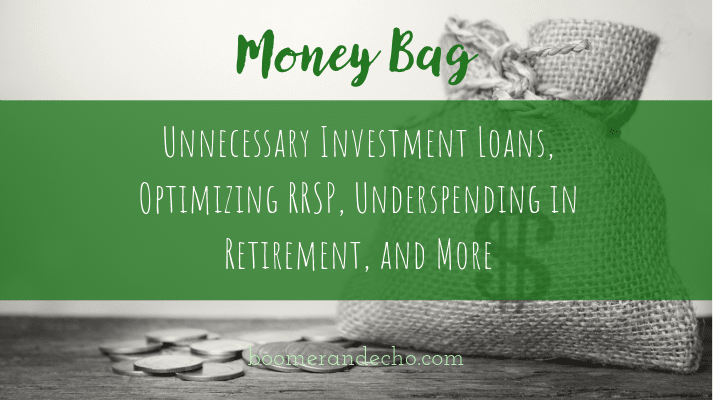
Welcome to the Money Bag, where I answer questions and address comments from readers on a wide range of money topics, myths, and perceptions about money. No question is off limits, so hit me up in the comments section or send me an email about any money topic that’s on your mind.
Today, I’m answering reader questions about borrowing to invest, optimizing your RRSP, market timing, the reluctance to spend in retirement, and switching from dividend stocks to index funds.
First up is Andrea, whose financial advisor is trying to talk her into setting up an investment loan. Take it away, Andrea!
Should I borrow to invest?
My advisor suggested using a HELOC, paying only the interest, and using the rest to invest (obviously in hopes of gaining a higher return than the cost of the HELOC interest). Do you think this is a wise idea?
Hi Andrea, I’ve recently helped several clients extract themselves from unnecessary investment loans. It’s one of those ideas that looks good on paper but is not so great in real life.
Interest is tax deductible, yes. But that’s a one-time savings when you file your taxes. You still need to service the loan interest each month.
What are you investing in? It should be high enough exposure to equities to give you a higher expected investment return than the loan interest, but not too risky (betting on individual stocks) and not too expensive (what kind of fees are you paying to your advisor?).
Stocks can fall sharply (34% in March 2020, or down 12-18% in 2022 depending on the index).
How would you feel about a $140,000 market value when your loan is $200,000?
Investment loans are great for investment advisors because they get a loan on the books and an investment to manage (from which to extract fees).
Finally, are your other goals being fulfilled (optimize RRSP, maximize TFSA, prioritizing other goals like living your best life)?
All more important than creating a tax deductible investment loan.
What does it mean to optimize your RRSP?
Next up is Tim, who wanted clarification on my suggested way to optimize your RRSP contributions when you have an employer matching RRSP.
In a recent Weekend Reading edition, you suggest to ”contribute enough to max out the match, but no more” when it comes to employer matching savings plans. Why not contribute more?
Let’s say someone earns $100,000 per year and can contribute 18% of his income to RRSPs. At work, five percent would come from the employee and five percent would come from the employer’s match, for a total of 10%. But what about the remaining eight percent? Why not maxing out the RRSP with the employer only? What are the cons with this approach?
Hi Tim, the answer is a bit nuanced. First of all, it might make sense to contribute the extra 8% but I would only do that in the context of my next point, which is to “optimize” your RRSP within your marginal tax bracket. Take the free money with the match, yes, but the extra contribution is either warranted or not. If not, maybe TFSA makes more sense.
If it does make sense to contribute more to the RRSP, my point is that most people should do that in a personal RRSP that is not tied to the group plan. Remember the group plan often limits its members to a narrow menu of investment options, which most of the time will be higher fees than an ETF that you can buy on your own.
So, the idea is that you’ll take the free money and max out your employer matching plans, then possibly contribute more to your RRSP, but do that in a personal RRSP and invest in lower cost ETFs.
Is a market crash coming?
Next, we have Adam who is feeling nervous about a post-election market crash and wants to know what to do about it.
Hi Robb: I keep reading about the impending market downturn after the election glee is over.
That said, since my wonderful foray into VEQT (with your encouragement,) should I be taking steps to secure my portfolio by moving say half of VEQT to a more balanced fund? Will you be writing about this in the near future?
Hi Adam, you’ll find no shortage of opinions on when the market is going to crash (and how bad). Whether it’s the election, or aftermath, or the next big thing that people are nervous about there will always be a reason for panicky investors to sell.
Your investing strategy should not change based on market conditions.
Meaning, if you are investing for the long haul and are in an asset mix that you’re comfortable with, then stay the course and ignore punditry and short-term price fluctuations.
Moving half of your VEQT into VBAL just creates VGRO (an 80/20 portfolio). If an 80/20 portfolio allows you to more comfortably stay in your seat then that might be a prudent move.
Just know that if VGRO existed during the great financial crisis it would have fallen 33.89% from June 2007 to March 2009 (45 months). So it’s not like 80% stocks is substantially less risky than 100% stocks (which fell 42.06% during that same time period).
Finally, know that the US market is not THE entire global market. It’s why you’re invested in VEQT (14,000+ global stocks) and not VFV (500 US large cap stocks). You’re taking risk, but you’re diversifying that risk around the world.
Stocks will absolutely fall at some point. But they’ll also recover eventually and make new all-time highs. That’s the nature of investing.
Market timing is a great way to end up poorer and drive yourself mad.
Why don’t retirees spend their money?
Next we have Darlene, who wants to know why retirees are so reluctant to spend their money.
Hi Robb, you mention retirees don’t spend up to their capacity. What’s driving this reluctance to spend down to zero, and what are they holding on to the money for? And do they really need to spend to zero?
Hi Darlene, the reluctance to spend comes from a fear of running out of money, either from a bad market crash, higher than normal inflation, high expenses on healthcare as they age, or from a higher-than-normal life expectancy.
A good retirement plan can help alleviate those fears, showing a range of outcomes using conservative assumptions on spending, inflation, longevity, and rates of return.
I don’t think anyone should be planning to truly die with zero – you need a margin of safety – but in my experience most retirees are not spending nearly up to their capacity due to the above fears and concerns.
I like to give my retired clients a spending range. A comfortable spending floor (typically what they’re spending now) that they could easily stick to in good times or bad, and then a safe spending ceiling that they could spend up to if desired without worrying about running out of money.
Related: Putting together your retirement income puzzle pieces
That range might look like an annual spending floor of $60,000 after-taxes, and an annual safe spending ceiling of $72,000. In reality, the sweet spot might be somewhere in the middle at $66,000, giving them a bit more spending capacity to enjoy retirement without causing too much anxiety that they’re overspending.
From dividend stocks to index funds: When to pull the trigger?
Finally, here’s a question from Jean about switching from dividend stocks to index funds.
I’ve been a successful dividend investor for about 20 years now and have been thinking of switching to indexing for a while. One of the main reasons for me to switch is that I’m getting older and losing the patience to manage my portfolio. Also, my family is not into it at all, so teaching them indexing would be much easier.
I have a pretty good idea what my final indexing strategy will look like. Something like VEQT with sprinkles of VCE/VV. Quite basic and simple!
My dilemma now is how to accomplish the transition? When and how do I pull the trigger?
Setting a date and doing it all at once seems to be the play like you did. But then, how do my manage my holdings till then? I’ve always had a long term approach and managing till the switch would be a pretty short term thing, hence a great part of my dilemma.
Any thoughts on all of that?
Hi Jean, you’ve listed some pretty compelling reasons to make the switch to indexing. As fun and interesting as it can be to manage your own stock portfolio, in my experience the juice is just not worth the squeeze anymore now that you can buy a single global index fund for the low price of 0.20% and get market returns without any effort.
No need for sprinkles, either. VEQT (or XEQT) has everything you need. Don’t overthink it!
Jean, this is a bit like getting into a cold pool or lake. Best to just jump in at once rather than stress about it and inch your way in.
Think of your portfolio as if it’s in cash right now. Would you buy all of your individual stocks again, or would you just buy your index fund?
Because that’s the exact same thing as selling all of your stocks at once and then immediately buying your ETF. You’re out of the market for a hot minute, and right back in with a globally diversified fund (minus some transaction fees, depending on your brokerage platform).
Pick a day – why not Monday at noon? The market is open, you can sell all of your stocks, and immediately buy your ETF. Done. No need to manage anything in the short term.
This is not like timing the market or anything. If you’re going to do it, best to get it over with and do it right away.
My only caveat to all of that is if you have large unrealized capital gains in a taxable account. More careful consideration needs to be taken there, likely with a financial planner or tax professional. I’ve worked with clients to sell their taxable holdings over a period of 2-3 years to spread out the capital gains hit.
There are no tax implications at all for selling stocks inside your registered accounts (RRSP, TFSA, and LIRA).
Do you have a money-related question for me? Hit me up in the comments below or send me an email.


